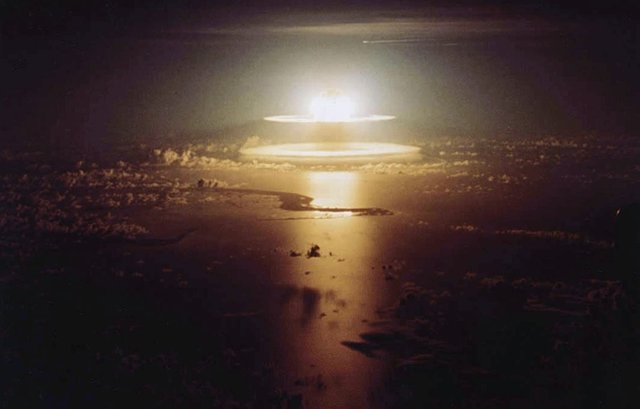The Vela Incident

In 1979, an odd "double flash" of light was detected by America's Vela Hotel Satellite near Antarctica. This event is known as the Vela Incident, or South Atlantic Flash.
The satellite, which launched in 1963 and orbited the Earth at an altitude of 67,000 miles, carried sensors that specifically detected neutrons, x-rays and gamma rays - common characteristics of a nuclear explosion - in addition to dual light flashes caused by atmospheric detonations. Even though the Cold War was ongoing at that time, the satellite violated various agreements, including the Partial Nuclear Test Ban Treaty.
Detection: Nuclear test or something else?
On September 22, 1979 at around 1:00 AM UTC, the Vela Hotel Satellite recorded a double flash at 47°S 40°E (between the Crozet Islands and Prince Edward Islands in the Indian Ocean). It was later estimated that a small yield equal to an atmospheric nuclear explosion of two to three kilotons caused the flash.
The Vela Incident: Nuclear Test or Meteoroid written by Jeffrey T. Richelson reports that other detection systems established by NATO, like the Missile Impact Location System (MILS) and Sound Surveillance System (SOSUS), provided no evidence the detonation was, in fact, a nuclear payload:
"In the 41 previous occurrences when a Vela satellite detected such a double flash, subsequent data confirmed that a nuclear detonation had actually occurred."
"Given the importance of determining if a test had taken place, and who had conducted a test if it had occurred, the U.S. government devoted a considerable effort to trying to gather and evaluate evidence in order to produce definitive conclusions."
After the aforementioned systems failed to determine whether or not the suspected explosion was nuclear-related, specialized aircraft were dispatched to the area by the Air Force Technical Applications Center (AFTAC). Their mission was to gather debris from the region for further analysis. The Central Intelligence Agency (CIA) also sent some of its personnel to various countries located near the event with the sole purpose of collecting potentially radioactive material. In the end, both efforts proved unsuccessful and the question remained: What had caused the dual light flashes?
Some have speculated the signal detected by the Vela Hotel Satellite was actually caused by a very small meteoroid striking the satellite itself, thus producing a false reading. Others believe the incident was not caused by man or nature; instead, they lean towards a more extraterrestrial explanation.
Considering the remote area where the signal originated and lack of explicable data, Author and UFO Researcher Mark A. Glancier thinks either an alien craft or earthly, but mysterious, entity created the blast:
"There have been many reports over the years of UFOs emerging from the sea. We often think of space as the great unexplored frontier, and it naturally is, but we forget about our oceans. Nearly 99% of the world's ocean floor has remained uncharted."
Credit
"You must also keep in mind that large explosion events have taken place on our planet for as long as it has existed. Some have even been recorded in ancient manuscripts. Obviously, the first 'modern' explanations are either an asteroid impact or possibly man-made, but if extraterrestrial visitations are in fact real, they would most likely possess destructive capabilities far beyond what we have today."
While nuclear test sites, such as Christmas Island and Chyornaya Guba (Black Bay), were usually located far from civilization, there is a good reason why the United States government's inability to explain the cause of the Vela Incident has led many to form their own theories.
As of 2016, the scientific debate over the South Atlantic Flash is said to have shifted to the side of a man-made weapon test.
Main image credit: The Atlantic